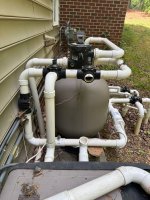This was an unpleasant surprise. A small branch (like 1" in diameter and very light) managed to do this damage during a wind storm. Fortunately the heater valves were turned off. I'm wondering how this could happen? Could it be attributed to not having water running through the lines?
I've propped up the bottom pipe that goes to the chlorinator with bricks as to not put strain on that section of pipe.
I'm also looking for guidance on the best strategy to repair this. I'm guessing that I'm going to have to replace the two 3-way valves, the check valve, but not sure about the flow sensor or the temperature sensor. Any guidance and suggestions you have are much appreciated! I imagine all the pvc has been glued together. I'm hoping to do this myself (I don't have much plumbing experience but am handy) and hoping to not to have to replumb the entire system. Certainly the output to the drain and the section running from the pump to the filter could remain intact. HELP!!!
Thanks,
Dan

I've propped up the bottom pipe that goes to the chlorinator with bricks as to not put strain on that section of pipe.
I'm also looking for guidance on the best strategy to repair this. I'm guessing that I'm going to have to replace the two 3-way valves, the check valve, but not sure about the flow sensor or the temperature sensor. Any guidance and suggestions you have are much appreciated! I imagine all the pvc has been glued together. I'm hoping to do this myself (I don't have much plumbing experience but am handy) and hoping to not to have to replumb the entire system. Certainly the output to the drain and the section running from the pump to the filter could remain intact. HELP!!!
Thanks,
Dan






